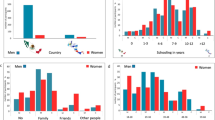Abstract
To identify and analyze the factors associated with the decision of migrants suffering violence while in transit through Mexico, to continue on their trip or turn back. Cross-sectional study combining quantitative and qualitative analyses. Socio-demographic and health characteristics, as well as types of violence and factors associated with the decision to continue on the trip, were explored for 862 migrants. 35 migrants were interviewed to explore their perceptions of migration, socioeconomic and political situations in their countries of origin, risks, violence experienced, and the decision to continue on their trip. Of the 862 migrants, 21.1 % experienced violence during their transit through Mexico towards the USA. Of these, 88.5 % decided to continue on their journey. This decision was positively associated with age (OR = 1.075, p < 0.05), number of children (OR = 3.161, p < 0.10), homicide rate in the country of origin (OR = 1.043, p < 0.10) and proximity to the northern border. No differences were observed by sex, schooling, days in transit and the presence of health problems. The decision to continue the journey to the United States was related to structural factors in the countries of origin, rather than risks in transit. It is necessary to implement mechanisms to promote and protect the human rights of migrants during their whole journey (origin, transit and destination).
Similar content being viewed by others
References
Delgado Wise R, Márquez Covarrubias H, Puentes R. Elementos para replantear el debate sobre migración, desarrollo y derechos humanos. México: Red Internacional de Migración y Desarrollo; 2010 [Consulted September 26 2011]. Available at http://rimd.reduaz.mx/documentos_miembros/111DelgadoMarquezPuente22102010.pdf.
Informe Especial sobre Secuestro de Migrantes en México. Comisión Nacional de los Derechos Humanos, febrero; 2011.
Castillo M. Los flujos migratorios en la frontera sur de México. Amérique Latine Histoire et Mémoire, Les Cahiers ALHIM; 2001 [Consulted September 26 2011]; 2. Available at http://alhim.revues.org/index603.html.
Leyva-Flores R, Guerra y Guerra G, ed. Fronteras y salud en América Latina: Migración, VIH-SIDA, violencia sexual y salud sexual y reproductiva. México: INSP/AECID/UNFPA; 2011.
Programa de las Naciones Unidas para el Desarrollo: Informe sobre Desarrollo Humano 2009. Superando barreras: Movilidad y desarrollo humanos. México: Mundi-Prensa; 2009.
Farmer P. An anthropology of structural violence. Curr Anthropol. 2004;45:305–25.
Kirchhoff S, Ibáñez AM. Displacement due to violence in Colombia: Determinants and consequences at the household level. ZEF-discussion papers on development policy No. 41. Germany: Bonn University; 2001.
Infante C, Idrovo AJ, Sánchez-Domínguez MS, Vinhas S, González-Vázquez T. Violence committed against migrants in transit: experiences on the northern Mexican border. J Immigr Minor Health. 2011;14(3):449–59.
Infante C, Aggleton P, Pridmore P. Forms and determinants of migration and HIV/AIDS-related stigma on the Mexican—Guatemalan border. Qual Health Res. 2009;19(12):1656–68.
Lupton D. Risk and sociocultural theory. Cambridge: Cambridge University Press; 1999.
Rodríguez E, Berumen S, Ramos LF. Migración centroamericana de tránsito irregular por México. Estimaciones y características generales. Instituto Nacional de Migración. Centro de estudios migratorios. Apuntes sobre migración. No. 1 julio; 2011.
Dalmasso C. Migración en América Latina: el dilema de los Derechos Humanos. Argentina: Grupo de Estudios Internacionales Contemporáneos GEIC; 2011.
Bowen KA, Marshall WN Jr. Deaths of Mexican and Central American children along the US border: the Pima County Arizona experience. J Immigr Minor Health. 2008;10(1):17–21.
World Bank: Crime and violence in Central America: a development challenge. World Bank; 2011.
Goldenberg SM, Strathdee SA, Perez-Rosales MD, Sued O. Mobility and HIV in Central America and Mexico: a critical review. J Immigr Minor Health. 2012;14(1):48–64.
Acknowledgments
The authors will like to thank the Migrants’ shelters who participated in this study and the migrants who voluntarily shared their testimonies and experiences.
Author information
Authors and Affiliations
Corresponding author
Rights and permissions
About this article
Cite this article
Servan-Mori, E., Leyva-Flores, R., Xibille, C.I. et al. Migrants Suffering Violence While in Transit Through Mexico: Factors Associated with the Decision to Continue or Turn Back. J Immigrant Minority Health 16, 53–59 (2014). https://doi.org/10.1007/s10903-012-9759-3
Published:
Issue Date:
DOI: https://doi.org/10.1007/s10903-012-9759-3



